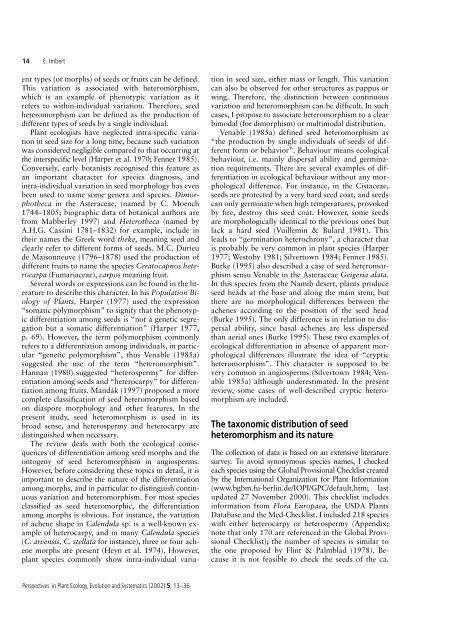Ecological consequences and ontogeny of seed ... - Accueil du site
Ecological consequences and ontogeny of seed ... - Accueil du site
Ecological consequences and ontogeny of seed ... - Accueil du site
You also want an ePaper? Increase the reach of your titles
YUMPU automatically turns print PDFs into web optimized ePapers that Google loves.
14 E. Imbert<br />
ent types (or morphs) <strong>of</strong> <strong>seed</strong>s or fruits can be defined.<br />
This variation is associated with heteromorphism,<br />
which is an example <strong>of</strong> phenotypic variation as it<br />
refers to within-indivi<strong>du</strong>al variation. Therefore, <strong>seed</strong><br />
heteromorphism can be defined as the pro<strong>du</strong>ction <strong>of</strong><br />
different types <strong>of</strong> <strong>seed</strong>s by a single indivi<strong>du</strong>al.<br />
Plant ecologists have neglected intra-specific variation<br />
in <strong>seed</strong> size for a long time, because such variation<br />
was considered negligible compared to that occurring at<br />
the interspecific level (Harper et al. 1970; Fenner 1985).<br />
Conversely, early botanists recognised this feature as<br />
an important character for species diagnosis, <strong>and</strong><br />
intra-indivi<strong>du</strong>al variation in <strong>seed</strong> morphology has even<br />
been used to name some genera <strong>and</strong> species. Dimorphotheca<br />
in the Asteraceae, (named by C. Moench<br />
1744–1805; biographic data <strong>of</strong> botanical authors are<br />
from Mabberley 1997) <strong>and</strong> Heterotheca (named by<br />
A.H.G. Cassini 1781–1832) for example, include in<br />
their names the Greek word theke, meaning <strong>seed</strong> <strong>and</strong><br />
clearly refer to different forms <strong>of</strong> <strong>seed</strong>s. M.C. Durieu<br />
de Maisonneuve (1796–1878) used the pro<strong>du</strong>ction <strong>of</strong><br />
different fruits to name the species Ceratocapnos heterocarpa<br />
(Fumariaceae), carpos meaning fruit.<br />
Several words or expressions can be found in the literature<br />
to describe this character. In his Population Biology<br />
<strong>of</strong> Plants, Harper (1977) used the expression<br />
“somatic polymorphism” to signify that the phenotypic<br />
differentiation among <strong>seed</strong>s is “not a genetic segregation<br />
but a somatic differentiation” (Harper 1977,<br />
p. 69). However, the term polymorphism commonly<br />
refers to a differentiation among indivi<strong>du</strong>als, in particular<br />
“genetic polymorphism”, thus Venable (1985a)<br />
suggested the use <strong>of</strong> the term “heteromorphism”.<br />
Hannan (1980) suggested “heterospermy” for differentiation<br />
among <strong>seed</strong>s <strong>and</strong> “heterocarpy” for differentiation<br />
among fruits. M<strong>and</strong>ák (1997) proposed a more<br />
complete classification <strong>of</strong> <strong>seed</strong> heteromorphism based<br />
on diaspore morphology <strong>and</strong> other features. In the<br />
present study, <strong>seed</strong> heteromorphism is used in its<br />
broad sense, <strong>and</strong> heterospermy <strong>and</strong> heterocarpy are<br />
distinguished when necessary.<br />
The review deals with both the ecological <strong>consequences</strong><br />
<strong>of</strong> differentiation among <strong>seed</strong> morphs <strong>and</strong> the<br />
<strong>ontogeny</strong> <strong>of</strong> <strong>seed</strong> heteromorphism in angiosperms.<br />
However, before considering these topics in detail, it is<br />
important to describe the nature <strong>of</strong> the differentiation<br />
among morphs, <strong>and</strong> in particular to distinguish continuous<br />
variation <strong>and</strong> heteromorphism. For most species<br />
classified as <strong>seed</strong> heteromorphic, the differentiation<br />
among morphs is obvious. For instance, the variation<br />
<strong>of</strong> achene shape in Calen<strong>du</strong>la sp. is a well-known example<br />
<strong>of</strong> heterocarpy, <strong>and</strong> in many Calen<strong>du</strong>la species<br />
(C. arvensis, C. stellata for instance), three or four achene<br />
morphs are present (Heyn et al. 1974). However,<br />
plant species commonly show intra-indivi<strong>du</strong>al varia-<br />
Perspectives in Plant Ecology, Evolution <strong>and</strong> Systematics (2002) 5, 13–36<br />
tion in <strong>seed</strong> size, either mass or length. This variation<br />
can also be observed for other structures as pappus or<br />
wing. Therefore, the distinction between continuous<br />
variation <strong>and</strong> heteromorphism can be difficult. In such<br />
cases, I propose to associate heteromorphism to a clear<br />
bimodal (for dimorphism) or multimodal distribution.<br />
Venable (1985a) defined <strong>seed</strong> heteromorphism as<br />
“the pro<strong>du</strong>ction by single indivi<strong>du</strong>als <strong>of</strong> <strong>seed</strong>s <strong>of</strong> different<br />
form or behavior”. Behaviour means ecological<br />
behaviour, i.e. mainly dispersal ability <strong>and</strong> germination<br />
requirements. There are several examples <strong>of</strong> differentiation<br />
in ecological behaviour without any morphological<br />
difference. For instance, in the Cistaceae,<br />
<strong>seed</strong>s are protected by a very hard <strong>seed</strong> coat, <strong>and</strong> <strong>seed</strong>s<br />
can only germinate when high temperatures, provoked<br />
by fire, destroy this <strong>seed</strong> coat. However, some <strong>seed</strong>s<br />
are morphologically identical to the previous ones but<br />
lack a hard <strong>seed</strong> (Vuillemin & Bulard 1981). This<br />
leads to “germination heterochrony”, a character that<br />
is probably be very common in plant species (Harper<br />
1977; Westoby 1981; Silvertown 1984; Fenner 1985).<br />
Burke (1995) also described a case <strong>of</strong> <strong>seed</strong> heteromorphism<br />
sensu Venable in the Asteraceae Geigeria alata.<br />
In this species from the Namib desert, plants pro<strong>du</strong>ce<br />
<strong>seed</strong> heads at the base <strong>and</strong> along the main stem, but<br />
there are no morphological differences between the<br />
achenes according to the position <strong>of</strong> the <strong>seed</strong> head<br />
(Burke 1995). The only difference is in relation to dispersal<br />
ability, since basal achenes are less dispersed<br />
than aerial ones (Burke 1995). These two examples <strong>of</strong><br />
ecological differentiation in absence <strong>of</strong> apparent morphological<br />
differences illustrate the idea <strong>of</strong> “cryptic<br />
heteromorphism”. This character is supposed to be<br />
very common in angiosperms (Silvertown 1984; Venable<br />
1985a) although underestimated. In the present<br />
review, some cases <strong>of</strong> well-described cryptic heteromorphism<br />
are included.<br />
The taxonomic distribution <strong>of</strong> <strong>seed</strong><br />
heteromorphism <strong>and</strong> its nature<br />
The collection <strong>of</strong> data is based on an extensive literature<br />
survey. To avoid synonymous species names, I checked<br />
each species using the Global Provisional Checklist created<br />
by the International Organization for Plant Information<br />
(www.bgbm.fu-berlin.de/IOPI/GPC/default.htm; last<br />
updated 27 November 2000). This checklist includes<br />
information from Flora Europaea, the USDA Plants<br />
Database <strong>and</strong> the Med-Checklist. I included 218 species<br />
with either heterocarpy or heterospermy (Appendix;<br />
note that only 170 are referenced in the Global Provisional<br />
Checklist); the number <strong>of</strong> species is similar to<br />
the one proposed by Flint & Palmblad (1978). Because<br />
it is not feasible to check the <strong>seed</strong>s <strong>of</strong> the ca.


